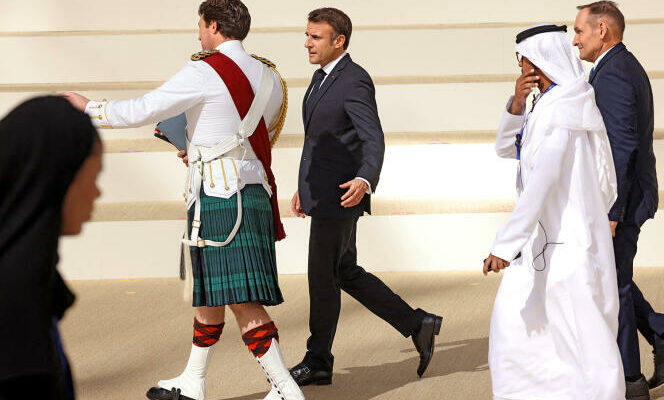COP or not COP?
Where is he walking towards? Towards a conference on the art of “decarbonizing without upsetting investors”? Or towards a round table on “the economic prospects linked to the conversion of oil into energy drinks”? Neither. This 1er December, President Emmanuel Macron heads towards a photo session intended to immortalize this great moment of communion, solidarity and above all hope that is COP28. In Dubai, world leaders have gathered to fight global warming and offer us an enchanted future. Yay!
Faith anchored in the foot
To walk quickly (isn’t there, after all, a climate emergency?), the head of state put on a pair of black leather shoes with two metal buckles. In this case, this type of model, invented by the venerable English house John Lobb almost eighty years ago, bears the name “double monk”, Or “double monk”, in French. Why such a name ? Quite simply because monks historically loved shoes with buckles.
Show white “spat”
To get to the photo session, the French president can count on a guide full of panache, also spectacularly shod. On these black boots rest what the English call spats (“gaiters”). The height of masculine elegance in the 1920s, spats had the primary function of protecting boots from mud and rain, but over time became an object of virilist one-upmanship. The most elegant and wealthy men took pride in constantly wearing spats immaculate white and despised those whose spats were soiled.
Scottish touch
The interest of this outfit does not stop at spats. This member of the Canadian delegation here donned his mess dress uniform, is the most formal outfit available to the military. He wears a white Spencer, a red scarf and above all a kilt. Why a Canadian in a kilt? you ask. Because sixteen regiments of the Canadian army today continue the dress code of the Scottish army, to recall the historical links which unite the two countries… In the 18th centurye century, in fact, many Scots migrated to Canada.
hold the rope
Since you don’t have travel sickness (clothing), let’s finally focus on this man on the right, and more precisely on the ribbon which surrounds his head. What is it about ? From an agal, of course. Originally intended to tie the legs of camels to prevent them from escaping at night, this thick black rope tightened on a core of goat’s wool allows the men of the Arabian Peninsula to keep their shemagh (or keffiyeh) in place, while offering them, incidentally, the appropriate support for a delicate touch of perfume…
